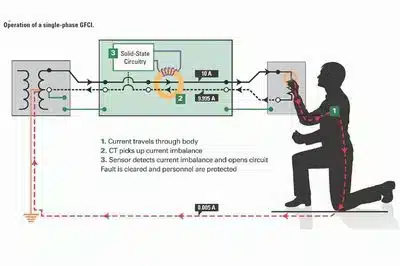Last edit: 03/08/2023

A GFCI (Ground Fault Circuit Interrupter) is the American equivalent of the High Sensitivity Differential protection or “Salva Vita” in Italian. It detects if the current is flowing where it should not (ground fault) and shuts off the power. It triggers at 6mA (and should not trigger below 4mA). Touching a live conductor that is protected by a GFCI will still cause a shock, but the GFCI will open the circuit before it becomes lethal.
They are used in the USA and Canada in bathrooms and kitchens at home, where they protect people from electric shock by quickly interrupting the circuit as soon as a ground fault is detected. Simple and reliable, this technology is credited with cutting residential electrocutions in the USA in half since it was mandated by the NEC in the 70s.
A different story can be told about the workplace. From 1992-2002, there were 3,348 electrocutions on the job in the USA. Despite higher voltages in the workplace that increase the danger of shock, only recently has GFCI technology become available for industrial and commercial settings. The first UL Listed GFCI for applications up to 600 V became available in 2012.
An industrial GFCI (UL calls it a “special purpose” GFCI) operates like any other, except for some important differences. First, the trip threshold is set at 20 mA, higher than its residential cousin. Second, the GFCI device must monitor the ground wire for open connections, so that if the connection to ground is lost, then the device will open the circuit. Third, an industrial GFCI interrupts higher power, so it must be much larger. It mounts like an electrical panel or inside an existing electrical cabinet.
UL 943C sets the trip threshold of industrial GFCIs at 20 mA — low enough to provide worker shock protection but high enough in most applications to avoid nuisance tripping. Like household GFCIs, their response to ground current follows an inverse-time curve; a current of 20 mA will cause a trip in about 1 s (quickly enough to prevent injury at this current level), and higher currents will cause a trip within 20 ms.
In some cases, the 20 mA trip threshold may still cause nuisance tripping. One option is an equipment ground-fault protection device (EGFPD), which is like a GFCI except it has adjustable trip settings from 6 to 50 mA. Although EGFPDs protect workers against shock, UL lists them in a category for equipment protection rather than for people protection.
This is a safety technology that has been long overdue. Now that UL Listed industrial GFCIs are available, the adoption of such protection will grow. Industrial GFCIs are not required by the electrical code, but if the history of residential GFCIs are a model, then the code may be updated to require GFCIs in more industrial applications.
We expect Industrial GFCI to be made compulsary in the 2014 edition of the NEC.
For any questions regarding the NEC (NFPA 70) or the CEC (C22.1) do not hesitate to contact us.